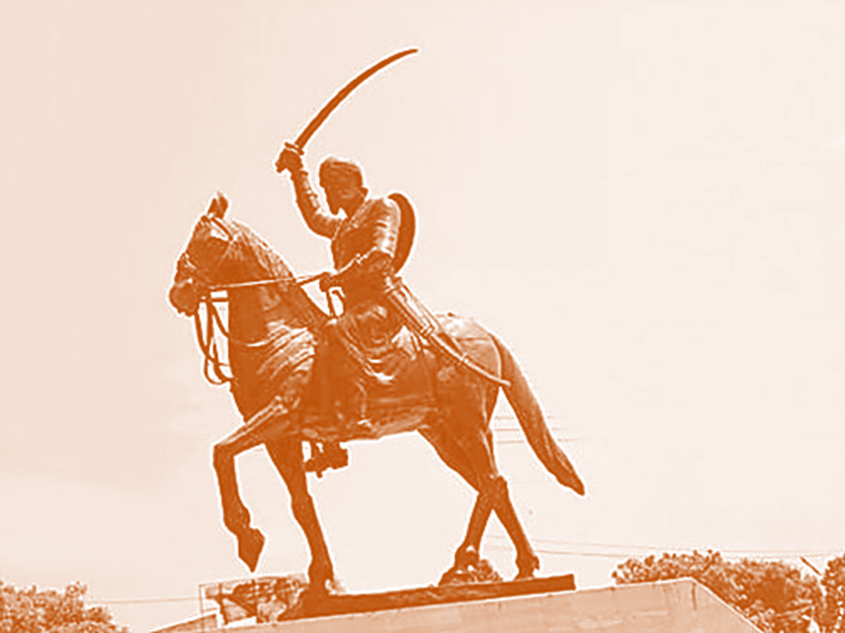On 8th April 1857, Parade grounds at Barrackpore, West Bengal witnessed the hanging of Sepoy Mangal Pandey who shot the first bullet against the British Empire. Little did the British know that Mangal Pandey dead was more frightening than Mangal Pandey alive. With each passing day, more and more units started revolting against the empire. From Meerut and Delhi to Cawnpore, from Lucknow to Danapur in Bihar, the flames of the great sepoy mutiny of 1857 quickly spread like a wildfire to every nook and corner of India.
Leading a pack of rebel soldiers in Danapur (Bihar) was an old warrior – Veer Kunwar Singh. A descendent of the Ujjainiya Rajput clan, Kunwar Singh was born in a rich royal family in Jagdishpur Bihar. The execution of Mangal Pandey infuriated this fearless warrior who was well past his prime at that time. When Kunwar Singh decided to lead the uprising in Bihar, he was 80 years old. Kunwar Singh was a champion swordsman and a master of Guerrilla warfare
An excerpt from Veer Savarkar’s book “1857 ka Bhartiya Swatantrata Samar” reads:
“In the 1857 revolution, Veer Kunwar Singh had no peers in the strategy and skill of war. After Shivaji, He was the only one to prove the efficacy of guerrilla warfare. He was the only one who had the complete knowledge of this skill.”
His pack of soldiers demolished the English camp at Danapur and marched to Ara, the then district headquarters. Sensing that his Army was no match to the huge British Army, Kunwar Singh carefully orchestrated the attacks. Kunwar Singh’s army pounced upon the British army from bushes at the points of greatest concentration inflicting maximum damage. Such was his plan and the very execution of it that the city of Ara was under the complete control of Kunwar Singh in less than a day’s fight. For the first time in the History of India, the Royal Cross was brought down and Kunwar Singh’s royal flag was hoisted. British were in no position to lose the control of the district headquarters; hence they attacked Kunwar Singh. But the spirited army drove the British out of the town twice and maintained the control on Ara. British army attacked Ara again, this time with more force. The small army of Kunwar Singh was outnumbered by British units and hence British took control of Ara again.
But Kunwar Singh didn’t lose his heart. He escaped with whatever little was left of his small army and led the skirmish at Azamgarh. He again tried his Guerrilla tricks in the battle of Azamgarh. After two days of recurrent skirmishes, Kunwar Singh was successful in driving the British Army out of Azamgarh as well and once again the royal cross was brought down under his command. It is said that British General Douglas got so frustrated with Kunwar Singh’s antics that he ordered the entire corps under his command to attack him. A massive army attacked Kunwar Singh’s men in Azamgarh and took control of it again. But Kunwar Singh escaped again with his militia and proceeded towards his hometown in Ara. Captain Le Grand attacked him on the way, but to their sheer surprise, Kunwar Singh and his men trampled them. Kunwar Singh went ahead and took control of Jagdishpur. Kunwar Singh was fatally wounded in this war and at the age of eighty this brave heart bid adieu to the world.
It is rumoured that upon meeting Kunwar Singh, Nana Sahib of Cawnpore was so awestruck by this aged chieftain that he touched his feet, asked for his blessings and requested him to share the secrets of Guerrilla warfare. It is also said that once while he was crossing Ganges, Captain Douglas’s army attacked him. One of their bullets hit Kunwar Singh’s left hand. Sensing that the bullet wound may cause severe infection, Kunwar Singh severed his left hand with his sword and offered it to the Ganges announcing “Oh mother Ganges, till the time your son is alive, no foreigner can take control of his land”. It is commonly believed that Kunwar Singh fought Le Grand’s army with just one hand.
Veer Kunwar Singh is an example of perpetual patriotism. His tale goes on to show how patriotism and courage is not at the mercy of age and it demonstrates how young-old, sick-healthy, men-women, rich and poor participated together in the struggle for freedom. Veer Kunwar Singh will forever remain an inspiration for millions of Indians for his unmatched valour, unparalleled audacity and astute military planning.
In the words of the R C Prasad Singh:
अस्सी वर्षो की हड्डी में, जागा जोश पुराना था,
सब कहते है कुंवर सिंह भी, बड़ा वीर मर्दाना था
PS: While researching for this article, I noticed that there is a complete dearth of information about Veer Kunwar Singh on the internet. I owe this article to my friends and acquaintances in Ara and Patna who took the pains of visiting Veer Kunwar Singh’s memorial in Jagdishpur and providing me with their inputs
